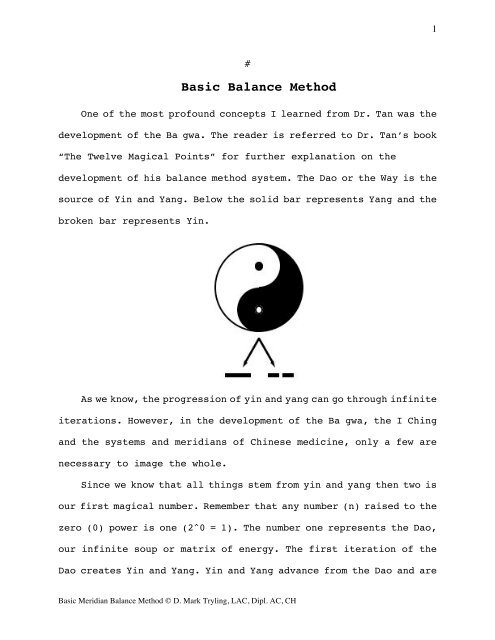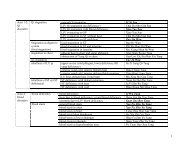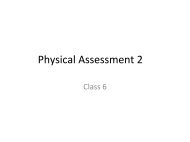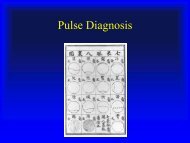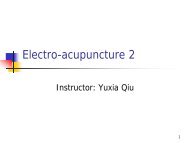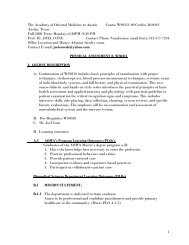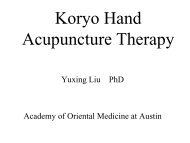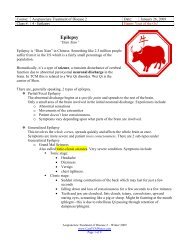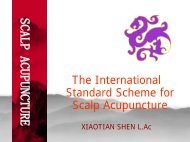balance method.pdf - CatsTCMNotes
balance method.pdf - CatsTCMNotes
balance method.pdf - CatsTCMNotes
You also want an ePaper? Increase the reach of your titles
YUMPU automatically turns print PDFs into web optimized ePapers that Google loves.
1#Basic Balance MethodOne of the most profound concepts I learned from Dr. Tan was thedevelopment of the Ba gwa. The reader is referred to Dr. Tan’s book“The Twelve Magical Points” for further explanation on thedevelopment of his <strong>balance</strong> <strong>method</strong> system. The Dao or the Way is thesource of Yin and Yang. Below the solid bar represents Yang and thebroken bar represents Yin.As we know, the progression of yin and yang can go through infiniteiterations. However, in the development of the Ba gwa, the I Chingand the systems and meridians of Chinese medicine, only a few arenecessary to image the whole.Since we know that all things stem from yin and yang then two isour first magical number. Remember that any number (n) raised to thezero (0) power is one (2^0 = 1). The number one represents the Dao,our infinite soup or matrix of energy. The first iteration of theDao creates Yin and Yang. Yin and Yang advance from the Dao and areBasic Meridian Balance Method © D. Mark Tryling, LAC, Dipl. AC, CH
2represented by the number two, (2^1 = 2). The second iteration issimilar to cell division. It divides and copies itself (on the bottomrow) and adds to it the opposing polarity on the second row (tomaintain <strong>balance</strong>). Numerically, we have four variations (2^2 = 4).YangYinTaiyang Shaoyang Shaoyin TaiyinMetal Fire Wood Water EarthDU LI-LU SI-HT SJ-PC LV-GB KI-UB SP-ST RNHeaven Lake Fire Thunder Wind Water Mountain EarthThe third iteration maintains the first row and adds to thesequence by changing the polarity of the second row and adding thethird row by alternating the symbols of yin and yang. This gives useight variations, (2^3 = 8).These are the eight basic trigrams of the Ba gwa. If we continuethe iteration process to the sixth level we will end up with thesixty-four hexagrams of the I Ching, (2^6 = 64).Basic Meridian Balance Method © D. Mark Tryling, LAC, Dipl. AC, CH
3So to review two (2) is a magical number represented by yinand yang. Three (3) is a magical number which generates the eighttrigrams of the Ba gwa (8 = 2^3 = 2 x 2 x 2). Six (6) is a magicalnumber which generates the sixty-four hexagrams of the I Ching (64= 2^6 = 2 x 2 x 2 x 2 x 2 x 2) and the six Chinese meridian names.The eight trigrams of the Ba gwa arrangement are shown below ina linear grouping. This linear grouping represents the basis for Dr.Tan’s first two <strong>balance</strong> <strong>method</strong> systems.Heaven Lake Fire Thunder Wind Water Mountain EarthThese eight trigrams, arranged in a circular grouping, are the basisfor the Fu Xi gwa shown below. This arrangement of the trigrams isthousands of years old. It is used in many aspects of Chinese culture,philosophy and medicine.Basic Meridian Balance Method © D. Mark Tryling, LAC, Dipl. AC, CH
4The circular arrangement of the Fu Xi gwa is the basis for Dr.Tan’s advanced <strong>balance</strong> <strong>method</strong> systems for internal disorders. Asummary of his basic <strong>balance</strong> systems is shown in the table below:The Five Basic Balance SystemsSystem 1 System 2 System 3 System 4 System 5Same ChineseMeridianNameOpp. SideOppositeChineseMeridianNameEither sidePairedInterior –ExteriorRelationshipOpp. SideOpposite onChineseClockEither sideNeighbor onChineseClockOpp. sideYin - YangTaiyin – YangmingShaoyin – TaiyangJueyin - ShaoyangDr. Tan’s Balance SystemHand MeridiansFoot MeridiansMetal Fire Wood Water Earth1 2 3 4 5 6 7 8Heaven Lake Fire Thunder Wind Water Mountain EarthDu Li – Lu Si - Ht Pc – Sj Gb – Lv Ub – Ki St - Sp RenSystem 1 and 2 DevelopmentThe most ultimate yang meridian is the Du and the most ultimateBasic Meridian Balance Method © D. Mark Tryling, LAC, Dipl. AC, CH
5yin meridian is the Ren. Therefore, the Du meridian is associatedwith the Heaven gwa and the Ren meridian is associated with the Earthgwa. From Five Element theory the other meridians are placedaccording to their association. The Metal Element corresponds to theLu and Li meridians. The Fire Element corresponds to the Ht and Simeridians. The Water Element corresponds to the Ki and Ub meridians.The Earth Element corresponds to the Sp and St meridians. The WoodElement corresponds to the Wind and Thunder gwa. As you can see, theHand meridians are on the left and the Foot meridians are on the right.Also notice the following <strong>balance</strong>s: Lu - Sp (Hand & Foot Taiyin),Li - St (Hand & Foot Yangming), Ht - Ki (Hand & Foot Shaoyin), Si- Ub (Hand & Foot Taiyang), Pc - Lv (Hand & Foot Jueyin), Sj - Gb(Hand & Foot Shaoyang). Notice the Wood element is the home of theJueyin and Shaoyang meridians. Also, notice that each gwa <strong>balance</strong>seach other, yin bar with yang bar: Heaven - Earth, Lake - Mountain,Fire - Water, Thunder - Wind.One approach to classify each gwa is to count the number ofsegments in each line and total them. For example Heaven has threesegments and Lake has 4 segments. Our earlier definition of a yangbar included just one segment, while our definition of a yin barincludes two segments. So a gwa with an even number of segments areclassified as yin and odd numbered segments are classified as yang.Therefore, Heaven is a yang gwa and Lake is yin gwa. Notice that fromside to side a yin gwa <strong>balance</strong>s a yang gwa and vice-versa. Note thatBasic Meridian Balance Method © D. Mark Tryling, LAC, Dipl. AC, CH
6both Shaoyang and Jueyin are assigned to the Wood Element. Thisdeviates from many schools of thought regarding the Sanjiao andPericardium zang-fu, which includes them in the Fire Element.However, it is easily seen that <strong>balance</strong> is maintained, across thecenterline of the table, with this “new” configuration for these twomeridians. Since the middle of our table separates the upper bodymeridians from the lower body meridians, it’s easy to see thatShaoyang belongs in the middle of our table, which agrees with TCMtheory.Ba Gwa Meridian AssignmentThere are five basic systems used to <strong>balance</strong> meridians. The firsttwo have been represented. The third system is dependent on anarrangement of the meridians, based on the Fu Xi gwa. Notice thateach is numbered one through eight.Basic Meridian Balance Method © D. Mark Tryling, LAC, Dipl. AC, CH
7Heaven 1Lake 2 Wind 5Fire 3 Water 6Thunder 4 Mountain 7Earth 8In this arrangement, Heaven represents the uppermost portions ofthe body (specifically the head) and is considered yang. In fact,imagine a person’s body standing in the middle of the Fu Xi gwa witharms outreached overhead one pointed toward the Lake gwa, the othertoward the Wind gwa. The two meridians that mostly occupy the headregion are the Gallbladder and Urinary Bladder meridians. Therefore,these two meridians are assigned to the Heaven gwa. Since Earth isa yin gwa opposite to Heaven, the two yin meridians that <strong>balance</strong> theHeaven gwa are the Kidney and Liver. So, we have now defined fourof the twelve primary meridians to two of the eight gwa. Six gwa andBasic Meridian Balance Method © D. Mark Tryling, LAC, Dipl. AC, CH
8eight meridians remain.Drawing an imaginary horizontal line through the body intersectsthe Fire gwa on the left and the Water gwa on the right. This linerepresents the middle jiao, which is governed by the Spleen andStomach meridians. The Fire gwa is a yin gwa and therefore the Spleenis assigned to it. Since the Water gwa is a yang gwa and Stomach<strong>balance</strong>s Spleen, Stomach is assigned to the Water gwa. Four gwa andsix meridians (Lung, Heart, Pericardium, Large Intestine, SmallIntestine, San Jiao) remain.Three of the remaining zang-fu, are physically, in the upper body.They are all yin meridians: Lung, Heart and Pericardium. Since theLake gwa mimics the shape of a “valentine” heart, then the Heart andPericardium are assigned to the Lake gwa. By default, the Lung isassigned to the Wind gwa.The Thunder gwa <strong>balance</strong>s the Wind gwa. Therefore, Large Intestineis assigned to the Thunder gwa. That leaves the Small Intestine andSan Jiao meridians to the Mountain gwa.Final System 3 ArrangementThe Dao manifests Yin and Yang, a system of bipolar opposites.The key word here is bipolar. The prefix bi- denotes “having two”.So, actually, all we have to really be concerneda b o u ti st h i sm a g i c a lnumber two and how to fully use it. In our earlier discussion of theBa gwa and the development of each gwa, we constructed each gwa fromyin and yang bars. As we discovered, the two separate bars can beBasic Meridian Balance Method © D. Mark Tryling, LAC, Dipl. AC, CH
9combined in such a way to form eight trigrams (2 x 2 x 2 = 2^3 = 8).The Fu Xi gwa arrangement is depicted below. This arrangement isbased on positioning each gwa in relation to the tai-ji yang-yinsymbol. System 3 <strong>balance</strong> is based on the interior-exteriorrelationship of each meridian.HeavenUB - GBLakeHT - PCWindLUFireSPWaterSTThunderLIMountainSI - SJEarthLV - KITo maintain <strong>balance</strong> we must have 4 Yang and 4 Yin gwa.Since the Heaven gwa represents ultimate Yang and has threesegments, all other gwa also having an odd number of segments mustalso be considered to be Yang. The Yang gwa are Heaven, Thunder, Waterand Mountain.Since the Earth gwa represents ultimate Yin and has six segments,Basic Meridian Balance Method © D. Mark Tryling, LAC, Dipl. AC, CH
10all other gwa also having an even number of segments must also beconsidered to be Yin. The Yin gwa are Lake, Fire, Wind and Earth.Right away you can see that there exists “yin within yang”, and“yang within yin”. For there can never be truly only one or the other.Dr. Tan’s Balance SystemMetal Fire Wood Water Earth1 2 3 4 5 6 7 8Heaven Lake Fire Thunder Wind Water Mountain EarthDu Li – Lu Si - Ht Pc – Sj Gb – Lv Ub – Ki St - Sp RenUb – Gb Ht – Pc Sp Li Lu St Si – Sj Lv - KiSystem 4 & 5Balance system 4 is based on the channel opposite on the Chinese clockfrom the channel requiring <strong>balance</strong>. Balance system 5 is based on thesame polarity (yin or yang) of the neighbor on the Chinese Clock.Basic Meridian Balance Method © D. Mark Tryling, LAC, Dipl. AC, CH
11System 6 & 7Some time (several years) after Dr. Tan defined the five basic <strong>balance</strong>systems, he began to add two more systems to his basic <strong>balance</strong> class.Balance system 6 is based on using a point on the sick channelunrelated, geographically, to the diseased region. Examples: UB57/58 for UB channel pain of the low back; GB 43 for Shaoyang typeheadaches; LV 8 for lower abdominal pain; GB 41-44 for tinnitus; SP3 and ST 3 for knee pain and swelling; LV 1 for hernia or genitalswelling; ST 36 for eye problems.Balance system 7 is based on three major channel groupings on theBasic Meridian Balance Method © D. Mark Tryling, LAC, Dipl. AC, CH
12Chinese Clock: Taiyin-Yangming (Metal-Earth), Shaoyin-Taiyang(Fire-Water) and Jueyin-Shaoyang (Wood). The <strong>balance</strong> meridians areas follows: LU-ST, LI-SP, HT-UB, SI-KI, PC-GB, SJ-LV.Acupuncture 1, 2, 31 Identify the sick meridians according to the cutaneousregions2 Choose the <strong>balance</strong> meridians3 Choose the points on the <strong>balance</strong> meridians based on mirroror imageBasic Meridian Balance Method © D. Mark Tryling, LAC, Dipl. AC, CH


